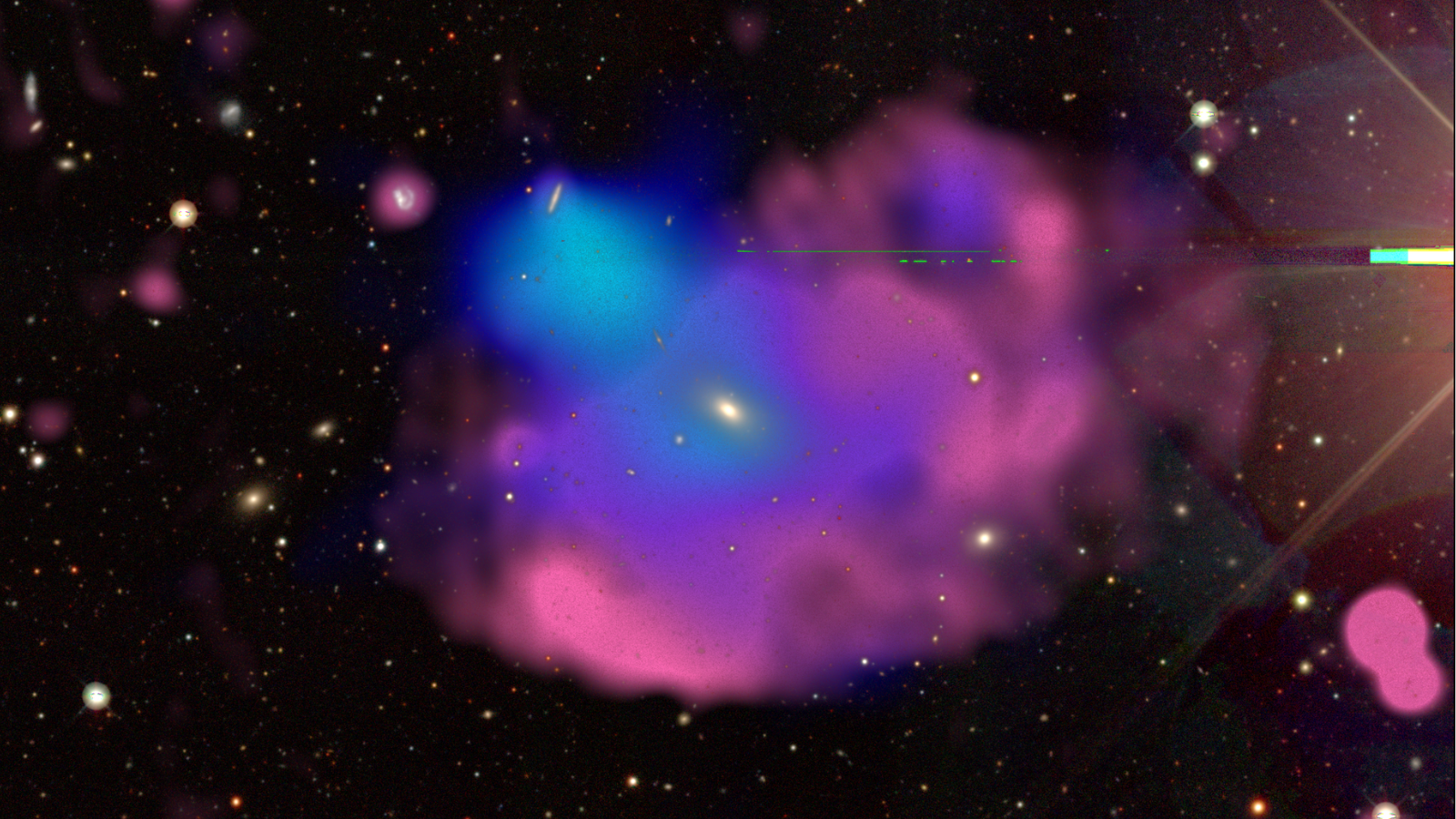
(Image credit: X. Zhang and M. Kluge (MPE), B. Koribalski (CSIRO))
XMM-Newton, a European Space Agency and NASA-operated space telescope, has imaged a vast cosmic “Cloverleaf” to uncover its mysterious origins.
The Cloverleaf is an example of an “odd radio circle,” or ORC. These objects are strange bubbles of radio light that are so huge they can be thousands of times the width of the Milky Way, thus encompassing an entire galaxy — sometimes, many.
ORCs were discovered in 2019 when the Australian Square Kilometer Array Pathfinder (ASKAP) picked up on the aptly named ORC-1. Since then, radio surveys of the cosmos have become sensitive enough to detect a further seven ORCs, one of which is the Cloverleaf, the subject of XMM-Newton’s observations.
The power needed to create such a structure is immense, leading astronomers to ponder about what events could be violent enough to create ORCs. Thanks to the observations XMM-Newton, researchers think the Cloverleaf’s creation event was a collision between two groups of galaxies.
Related: The mystery of vast ‘cosmic ORCs’ — odd radio circles that encompass entire galaxies — may be solved
“This is the first time anyone has seen X-ray emission associated with an ORC,” Esra Bulbul, leader of the team behind this investigation and an astrophysicist at the Max Planck Institute for Extraterrestrial Physics, said in statement. “It was the missing key to unlock the secret of the Cloverleaf’s formation.”
How to X-ray an ORC
A multitude of computer simulations have attempted to reconstruct the births of ORCs and have been able to recreate the shapes of these strange formations. Yet, none have recreated the intensity of the expansive radio emissions that define an ORC.
Bulbul realized, however, that ORCs hadn’t been studied in X-ray light before. The scientist reasoned such a study may constitute the missing piece of the puzzle. Together with Max Plank Institute postdoc Xiaoyuan Zhang, she set scanning data from the Extended Roentgen Survey with an Imaging Telescope Array (eROSITA) in search of such ORC-related emissions.
The duo found data of an X-ray emission that seemed to be linked to the Cloverleaf ORC gathered during just 7 minutes of eROSITA observing time. Though this was a tiny amount of data, however, it was enough to prompt Bulbul to gather a larger team and get five and a half hours of telescope time with XMM-Newton.
“We really got lucky,” Zhang said in the statement. “We saw several plausible X-ray point sources close to the ORC in eROSITA observations, but not the expanded emission we saw with XMM-Newton. It turns out the eROSITA sources couldn’t have been from the Cloverleaf, but it was compelling enough to get us to take a closer look.”

A clash between galaxies
X-ray emission from the Cloverleaf seen by XMM-Newton shows the distrubution of gas within a group of galaxies embedded in the ORC. This is sort of like a chalk outline at a crime scene.
By observing how this gas has been disturbed, the team could see that galaxies within the Cloverleaf were actually once part of two separate groups that drew together, collided and merged.
The X-ray emission also revealed the temperature of gas in the region, placing it at around around 15 million degrees Fahrenheit (8.3 million degrees Celsius). The greater the masses of galaxies involved in galactic pile-ups like this one, the greater the gravitational influence of the merger and the faster the gas gets dragged in. All of that, in turn, increases the temperature of infalling gas, meaning the temperature of this material can give scientists a clue as to how many galaxies were involved in the merger. You’d just need to work backward.
“That measurement let us deduce that the Cloverleaf ORC is hosted by around a dozen galaxies that have gravitated together, which agrees with what we see in deep visible light images,” Zhang said.
As for the radio emissions from the ORC, the team suggests these were generated by particles accelerated by shockwaves that rippled out from the galaxies as they were crashing together.

One issue with the team’s proposal is that galaxy group mergers are common, but ORCs, on the other hand, are rare. That means it isn’t yet certain how this particular galaxy group smashing together created the Cloverleaf, while similar events haven’t birthed such ORCs.
“Galaxies interact and coalesce all the time,” Kim Weaver, the NASA project scientist for XMM-Newton at NASA’s Goddard Space Flight Center who was not involved in the study, said in the statement. “But the source of the accelerated particles is unclear.”
She added that another possibility for the powerful radio signal may involve the the supermassive black holes that sit at the heart of each of the colliding galaxies. These black holes may have gone through episodes of feeding and extreme activity in the past. Relic electrons from that ancient activity could remain and may have been reaccelerated by galaxy group merger producing intense radio emissions.
The mystery of the Cloverleaf may have been solved, but the findings raise more questions about these vast radio emissions. The team will continue to study this ORC to settle those queries.
“Mergers make up the backbone of structure formation, but there’s something special in this system that rockets the radio emission,” Bulbul said. “We can’t tell right now what it is, so we need more and deeper data from both radio and X-ray telescopes.”
The team’s research was published on Tuesday (April 30) in the journal Astronomy and Astrophysics Letters.
Join our Space Forums to keep talking space on the latest missions, night sky and more! And if you have a news tip, correction or comment, let us know at: community@space.com.
Note: This article have been indexed to our site. We do not claim legitimacy, ownership or copyright of any of the content above. To see the article at original source Click Here













